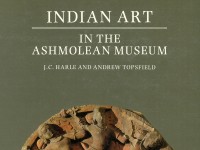Indian Art in the Ashmolean Museum
A catalogue of the Ashmolean’s collection of Indian art by J. C. Harle and Andrew Topsfield (published Oxford, 1987).

Publications online: 143 objects
Temple lamp
-
Literature notes
These seven objects belonged to a large collection of brass images, ritual objects, implements, ornaments and toys which was formed by Major (later colonel) C. Eckford Luard in the former Central Indian Agency between 1900 and 1903. Luard served in this area for a number of years as Superintendent of Gazetteer and of Census Operations. He compiled the several volumes of Central Indian State Gazetteers (1907-12), as well as writing other works, including guide-books to Dhar and Mandu and the Dilwara temples at Mount Abu. In later life he lived at Boar’s Hill, Oxford, and part of his collection was presented to the Indian Institute’s museum by his widow in 1936 [see EAOS.108]. Luard’s earlier article describing the collection in the Journal of Indian Art and Industry is still useful in the identification of regional types of such late brass objects, which are otherwise scantily documented.
Among the ritual objects from the collection is a massively sturdy, chalice-shaped temple lamp with a serrated rim [EAX.284], which is said to have come from a Śaiva shrine. Around the cup section appear four figures in high relief, of Gaṇeśa; Hanumān; Bhairava (a fierce aspect of Śiva) with his dog, holding in his hands a drum, a sword, a cup full of blood and a severed head; and the Goddess, carrying in her hands the mace and discus of Viṣṇu and the trident and sword of Śiva; a pair of pāduka (footmarks of Viṣṇu) also appear, with the sun and moon above them. -
Details
- Associated place
-
Asia › India › central India › Madhya Pradesh (place of creation)
- Date
- 18th - 19th century (1701 - 1900)
- Material and technique
- brass
- Dimensions
-
28 cm max. (height)
13.5 cm (diameter)
- Material index
-
processed material › metal › alloy › copper alloy › brass
- Technique index
- Object type index
- No. of items
- 1
- Credit line
- Presented by Mrs C. E. Luard, 1936.
- Accession no.
- EAX.284
-
Further reading
Harle, J. C., and Andrew Topsfield, Indian Art in the Ashmolean Museum (Oxford: Ashmolean Museum, 1987), no. 71e on pp. 61-64, pp. xii & 63, illus. p. 63
Location
Objects are sometimes moved to a different location. Our object location data is usually updated on a monthly basis. Contact the Jameel Study Centre if you are planning to visit the museum to see a particular object on display, or would like to arrange an appointment to see an object in our reserve collections.
Galleries
Publications online
-

Indian Art in the Ashmolean Museum
These seven objects belonged to a large collection of brass images, ritual objects, implements, ornaments and toys which was formed by Major (later colonel) C. Eckford Luard in the former Central Indian Agency between 1900 and 1903. Luard served in this area for a number of years as Superintendent of Gazetteer and of Census Operations. He compiled the several volumes of Central Indian State Gazetteers (1907-12), as well as writing other works, including guide-books to Dhar and Mandu and the Dilwara temples at Mount Abu. In later life he lived at Boar’s Hill, Oxford, and part of his collection was presented to the Indian Institute’s museum by his widow in 1936 [see EAOS.108]. Luard’s earlier article describing the collection in the Journal of Indian Art and Industry is still useful in the identification of regional types of such late brass objects, which are otherwise scantily documented.
Among the ritual objects from the collection is a massively sturdy, chalice-shaped temple lamp with a serrated rim [EAX.284], which is said to have come from a Śaiva shrine. Around the cup section appear four figures in high relief, of Gaṇeśa; Hanumān; Bhairava (a fierce aspect of Śiva) with his dog, holding in his hands a drum, a sword, a cup full of blood and a severed head; and the Goddess, carrying in her hands the mace and discus of Viṣṇu and the trident and sword of Śiva; a pair of pāduka (footmarks of Viṣṇu) also appear, with the sun and moon above them.
Notice
Object information may not accurately reflect the actual contents of the original publication, since our online objects contain current information held in our collections database. Click on 'buy this publication' to purchase printed versions of our online publications, where available, or contact the Jameel Study Centre to arrange access to books on our collections that are now out of print.
© 2013 University of Oxford - Ashmolean Museum








